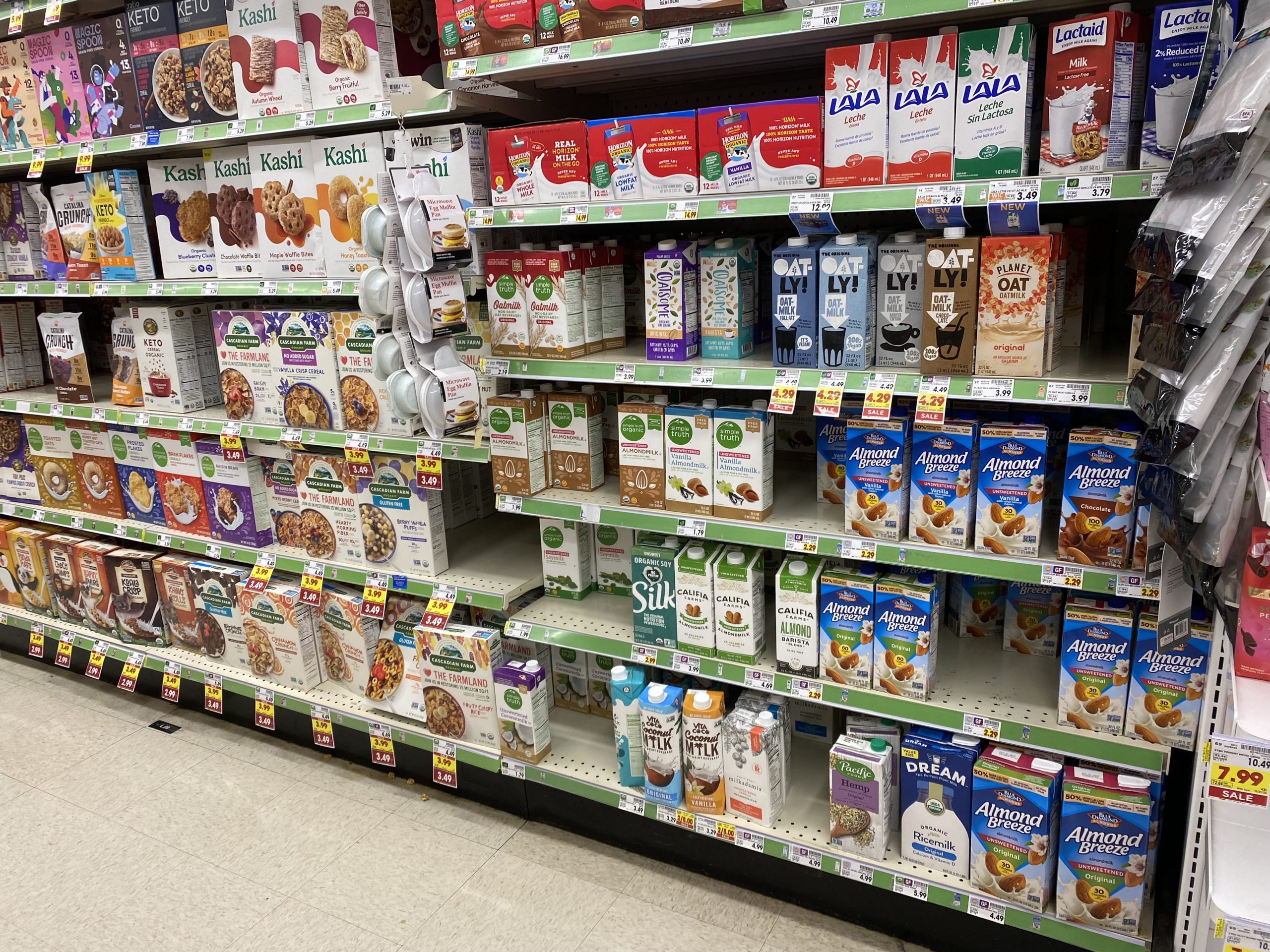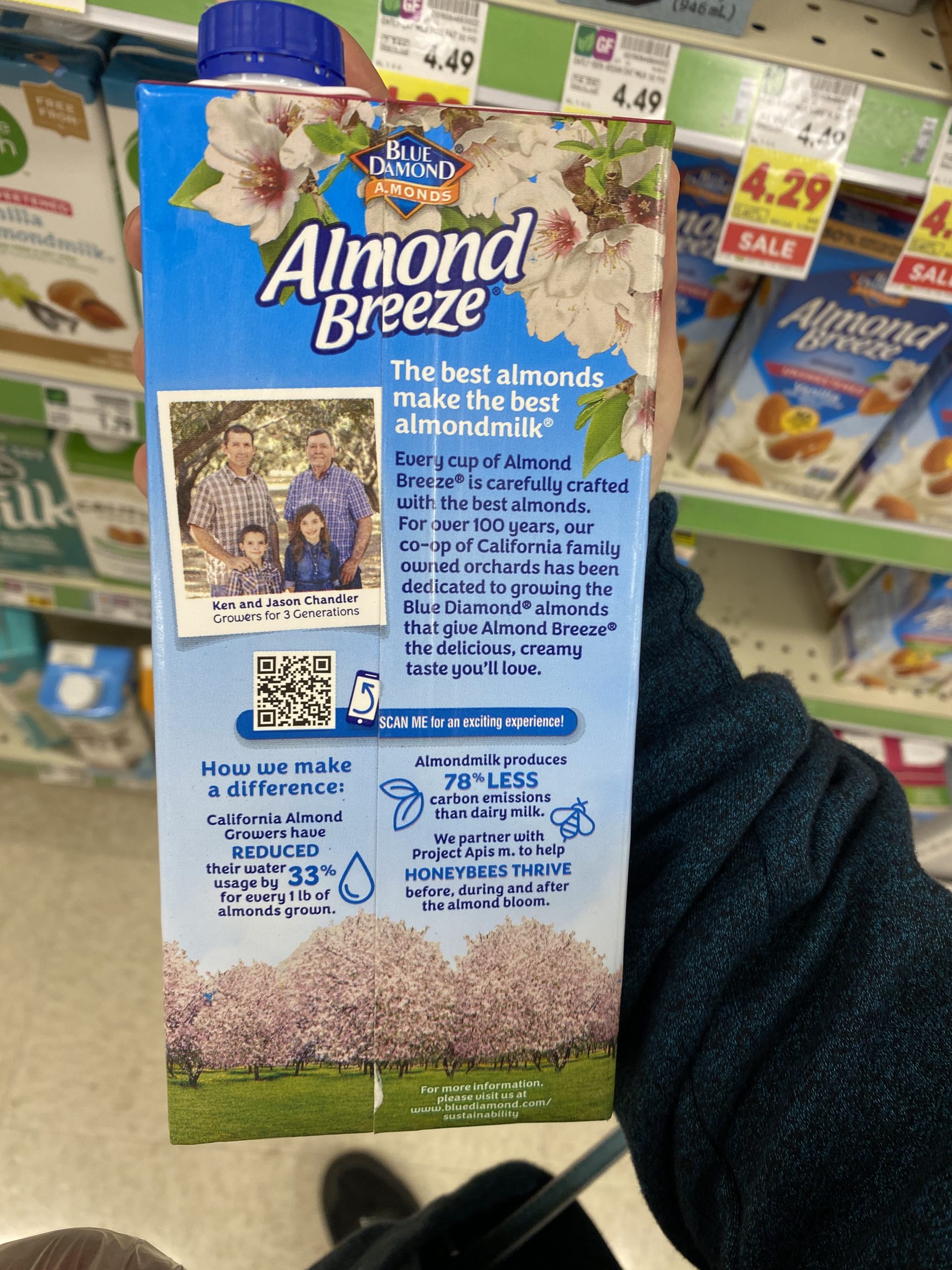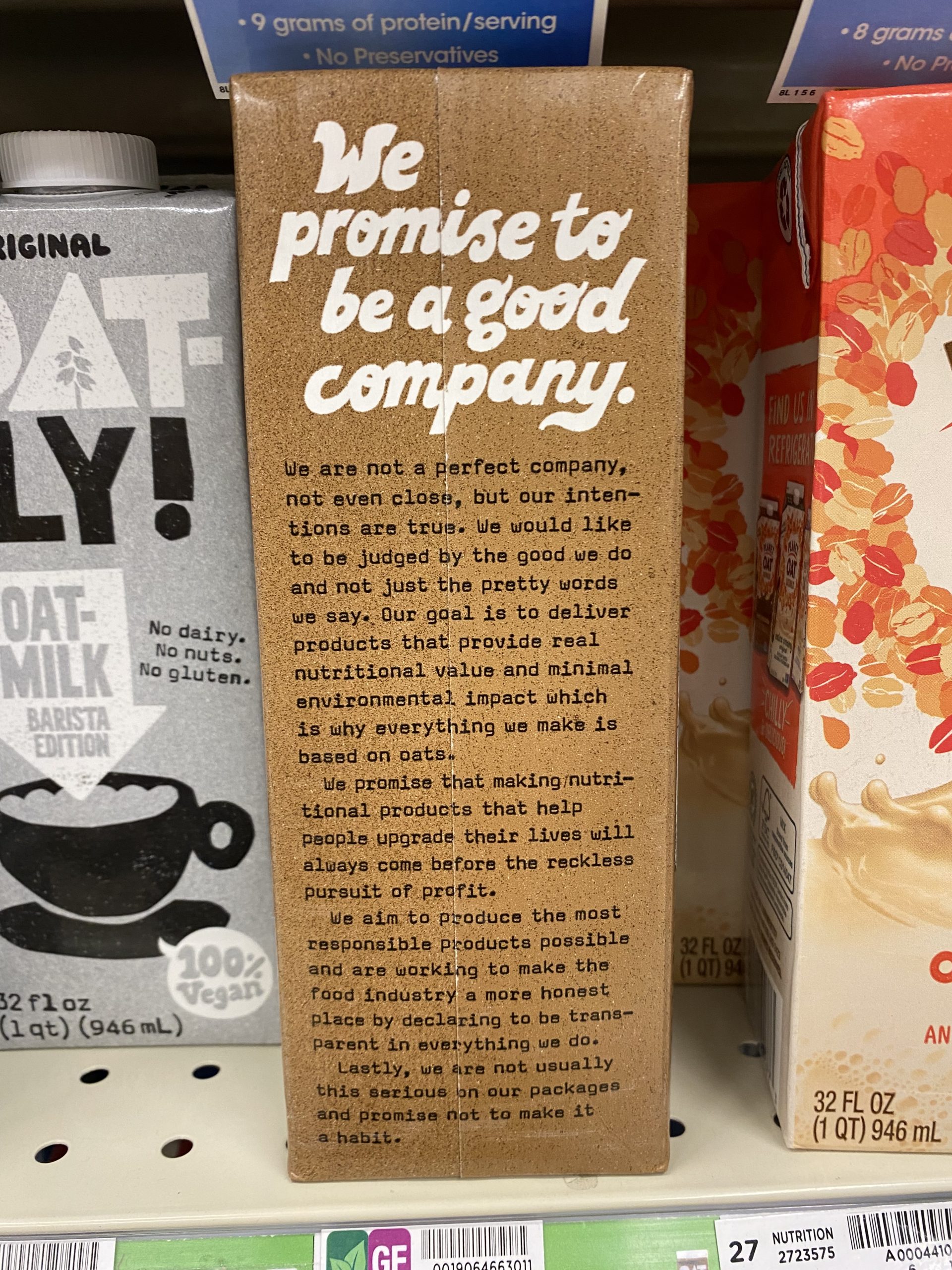6 Not All Milk is Created Equal
Britta Hess
Oats, almonds, cows, cashews, coconuts, soy, goats, rice, hemp, and more. The possibilities are endless when it comes to purchasing milk. Many grocery stores offer an assortment of milks to choose from. Every type of milk has its own unique flavor, consistency, and price. Consumers purchase certain kinds of milk for a variety of reasons. A majority of consumers who purchase milk alternatives usually pick what fits their dietary restrictions, nutritional needs, or simply what tastes best to them. Consumers are also becoming more conscious of their choices in products for both health and environmental reasons. Since milk alternatives are plant-based, some consumers see them as the better option, but these plant-based milks may actually be selling a false sense of hope for health and sustainability. There is a gap of knowledge in today’s society about the processes behind the production of regular milk and the alternative. But with so many choices at the store, it is difficult to make a decision on what milk reigns supreme in both sustainability and health benefits.

A Plethora of Milk
Milk has been a staple drink in many diets of cultures across the world for centuries. It has continued to be a staple beverage today, but has seen a shift in popularity in what it is primarily made of. I performed some field work research in multiple Kroger grocery stores across the Bloomington, Indiana area to see just how many types of milk there are available, not only for cow’s milk, but also for any milk alternative. When wandering around the refrigerated aisle, there is an overwhelming amount of milk to choose from. These range from whole, 2%, low fat, skim, lactose free, and even flavored cow’s milk like chocolate milk. Not far from the cow’s milk stands a small wall of milk alternatives in every store. A benefit to milk alternatives is that they do not always need to be refrigerated before opening, giving them the advantage of being easier to store and stock up on ahead of time. The unrefrigerated milk allows customers to find containers of them both in the refrigerated section and also in a separate aisle labeled “non-dairy”. Not every store has two milk aisles, but some of the areas where more milk can be found are next to the breakfast cereal or in the juice aisle.
many types of milk there are available, not only for cow’s milk, but also for any milk alternative. When wandering around the refrigerated aisle, there is an overwhelming amount of milk to choose from. These range from whole, 2%, low fat, skim, lactose free, and even flavored cow’s milk like chocolate milk. Not far from the cow’s milk stands a small wall of milk alternatives in every store. A benefit to milk alternatives is that they do not always need to be refrigerated before opening, giving them the advantage of being easier to store and stock up on ahead of time. The unrefrigerated milk allows customers to find containers of them both in the refrigerated section and also in a separate aisle labeled “non-dairy”. Not every store has two milk aisles, but some of the areas where more milk can be found are next to the breakfast cereal or in the juice aisle.
Delving Deeper into the Milk Glass
A vast majority of people are aware that cow’s milk comes from milking cows, and they may believe it is a simple, sustainable process using renewable resources. What consumers are unaware of is the environmental effects of the dairy industry. Several recent studies have been conducted to determine the effects on the environment of different food industries. In 2018, multiple points of data, that included the dairy industry, were consolidated into an academic paper and analyzed by Joseph Poore and Thomas Nemecek. These data included emissions, land use, freshwater withdrawals, and eutrophication (the build up of minerals and nutrients in a body of water) of 40 common foods. After analyzing the data and organizing it into tables and graphs, the results were clear. The animal product industry, including dairy, was exposed to be using up as much as 83% of the world’s farmland while producing up 58% of the different emissions caused by food (Poore, 2018). When comparing the emissions and other environmental effects on the graphs and tables from the compiled studies, it shows that dairy has more overall negative impacts on the environment than fruits, vegetables, and plant-based foods. Even today in the United States, a first world country, freshwater is a necessity that communities still struggle to receive. According to the World Wildlife Fund, 144 gallons are used to produce a single gallon of cow’s milk, with over 90% of the water going towards food for the dairy cows (2019). Water, a precious resource that many people still do not have access to, According to the World Wildlife Fund, 144 gallons are used to produce a single gallon of cow’s milk, with over 90% of the water going towards food for the dairy cows (2019). is being used to grow food to produce another beverage. It was also determined that animal products roughly only provide about 18% of our calories and 37% of our protein, according to Poore and Nemecek (2018). This evidence may suggest that the dairy cow is an incredibly inefficient industry.


One of the most common substitutes for cow’s milk that can be found in nearly every grocery store is almond milk. Some people would consider every plant-based product to be better for the environment simply because it is plant-based, but that is not always the case. On the back of their milk container, Almond Breeze almond milk by the company Blue Diamond touts some facts about how their almonds are grown. One of the facts is that they have reduced their water usage by 33% per one pound of almonds, but this does not state how much water they used before or how much water they use now. Almonds are grown in California, where droughts are commonplace, making freshwater particularly important. It takes 3.2 gallons of water to produce a single almond (Young, 2021). Because almond milk is essentially almond water, there are very few almonds actually in almond milk. Still, almond milk is the biggest user of freshwater out of all of the milk alternatives. But in comparison to cow’s milk, almond milk still uses less water to produce it, nearly half as much in fact according to the attached bar graphs (Poore, 2018). As the back of the Almond Breeze box claims, there may be a way to reduce water consumption for almond production, giving hope for this milk alternative to improve.

Another common milk alternative is oat milk. Oatly is a brand of oat milk that can be found in many milk alternative aisles. Like Almond Breeze, they include a message on the back of their container. They state a promise to their consumers that they will make their product as environmentally friendly as they can; a more heart-to-heart way of appealing to consumers than Almond Breeze. According to one study, oats are one of the most efficient crops to maintain regarding its water usage, using only 48 gallons per gallon of oat milk produced (Young, 2022). While this seems like a lot, it still pales in comparison to the 144 gallons of water per gallon of cow’s milk. This makes it the most water efficient milk alternative. But oats are not without downsides. “64% of oat crops in the top 13 oat-producing states are treated with pesticides and even more with chemical fertilizers…” (Young, 2022). Many studies throughout recent history have pointed to negative ecological and humane effects of fertilizers and pesticides. Raising oats using certain pesticides and fertilizers could have potential harmful effects down the road that scientists are not even aware of yet. Further research could benefit the oat milk industry to help reduce or eliminate harmful chemical use.
Over the years, soy milk has dipped in popularity, being replaced by almond or oat milk. Consumers can still find different brands of soy milk, including Silk brand soy milk, which also makes almond milk. While environmental effects in the U.S. are important, it is critical to think of global impacts of certain crops. Because soybean crops are hardy, they can be grown in a variety of places around the world. The downside to this is that soybean plantations have caused much deforestation of rainforests since much of the world’s soy is grown in Brazil and Argentina (Young, 2022). One key point to keep in mind is that a large portion of these soybeans are actually used for livestock feed, rather than for soy milk production. This livestock includes dairy cows. Up to 67% of deforestation contributed to crops grown specifically for livestock feed, (Poore, 2018). It is likely that not a large amount of these soybeans are specifically for soy milk production. More data would need to be collected to determine what percentage of the soybean industry is used for soy milk production specifically. In addition, soybeans are very similar to oat crops in various ways. Soy milk production was recorded by a research study to have a similar amount of CO2 emissions as oat milk (Young, 2022). It also utilizes approximately the same amount of land for soybean crops as what is used for growing oats. These details make soy milk a comparable substitute for oat milk, when comparing environmental impacts.
Weighing the Numbers
While consequences on the environment are important, it is crucial to consider the nutritional benefits for every milk, too. After all, why should you consume something that has little to no nutritional value if there is a more beneficial version available? Different brands can have different nutritional values to them, but because name brands are more widely available across different stores, it is important to consider those first and foremost. Generic versions usually have similar nutritional values to the name brand versions. The following comparisons are based off of a serving size of 1 cup. A major selling point of cow’s milk is the protein it contains. Protein provides you with strength and aids the body in repairing itself. Store varieties may vary in their protein content, but 2% milk usually contains 9 grams of protein. Silk brand regular soy milk contains a similar amount, sitting at 7 grams of protein, while Oatly brand original oat milk sits with 3 grams in a cup serving. Almond Breeze brand original almond milk contains 1 gram. Almond Breeze contains the most calcium with 35% of your daily value. Oatly and 2% cow’s milk have about the same amount of calcium with 25% of your daily value and Silk soy milk coming in close with 20% of your daily value. The mineral calcium is another imperative nutrient for not just bone and dental health, but many other bodily functions throughout your lifetime, too. For the people more concerned about the calcium in their milk, Almond Breeze contains the most calcium with 35% of your daily value. Oatly and 2% cow’s milk have about the same amount of calcium with 25% of your daily value and Silk soy milk coming in close with 20% of your daily value. Another major point consumers might look for on the nutrition label is the calorie count. A high caloric milk does not necessarily make it a less viable option, but it can still be a factor to weigh in when choosing the right milk. A cup of 2% cow’s milk contains 140 calories and oat milk is not far off with 120 calories. Silk soy milk has 80 calories and Almond Breeze contains 30 calories. There are other factors that consumers can weigh in with each milk such as vitamin contents, fats, and sugars. But with the information above, each milk has its own positives and negatives.
Raise a Glass of Your Choice
If a consumer went by the facts and data discussed above, they can finally make an unbiased, informed decision about which milk is good for the environment while being nutritional. But in a realistic world, the factually best choice is not always best for the consumer. Many people purchase a certain kind of milk for dietary restrictions such as allergies or certain diets. Others may not find the best milk very tasty and could choose the next best option. Everyone also has their own nutritional needs that one milk may suit better than the rest. What is most important for the milk industry is having knowledgeable consumers who are making educated decisions of what milk to buy, whether that be from a cow or a plant. Technological and scientific advances in the coming years may continue to make each milk more sustainable to farm, giving cow milk and the substitutes hope for a better future. So next time you see the slogan “Got milk?,” think to yourself: “Which milk?”
References
Franklin-Wallis, O. (2019, January 29). White Gold: The unstoppable rise of alternative milks. The Guardian. https://www.theguardian.com/news/2019/jan/29/white-gold-the-unstoppable-rise-of-alternative-milks-oat-soy-rice-coconut-plant
Poore, J., & Nemecek, T. (2018, June 1). Reducing food’s environmental impacts through producers and consumers. Science. https://www.science.org/doi/10.1126/science.aaq0216
Ritchie, H. (2022, January 19). Dairy vs. plant-based milk: What are the environmental impacts?. Our World in Data. https://ourworldindata.org/environmental-impact-milks
World Wildlife Fund. (2019, Winter). Milk’s impact on the environment. WWF. https://www.worldwildlife.org/magazine/issues/winter-2019/articles/milk-s-impact-on-the-environment
Young, O. (2021, November 14). Is almond milk bad for the environment?. Treehugger. https://www.treehugger.com/is-almond-milk-bad-for-the-environment-5191458
Young, O. (2022, April 1). Oat Milk vs. soy milk: Which is more environmentally friendly?. Treehugger. https://www.treehugger.com/oat-milk-vs-soy-milk-5223965
